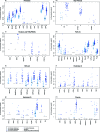Semivolatile endocrine-disrupting compounds in paired indoor and outdoor air in two northern California communities
- PMID: 20681565
- PMCID: PMC2930400
- DOI: 10.1021/es100159c
Semivolatile endocrine-disrupting compounds in paired indoor and outdoor air in two northern California communities
Abstract
Interest in the health effects of potential endocrine-disrupting compounds (EDCs) that are high production volume chemicals used in consumer products has made exposure assessment and source identification a priority. We collected paired indoor and outdoor air samples in 40 nonsmoking homes in urban, industrial Richmond, CA, and 10 in rural Bolinas, CA. Samples were analyzed by GC-MS for 104 analytes, including phthalates (11), alkylphenols (3), parabens (3), polybrominated diphenyl ether (PBDE) flame retardants (3), polychlorinated biphenyls (PCBs) (3), polycyclic aromatic hydrocarbons (PAHs) (24), pesticides (38), and phenolic compounds (19). We detected 39 analytes in outdoor air and 63 in indoor air. For many of the phenolic compounds, alkylphenols, phthalates, and PBDEs, these represent some of the first outdoor measures and the first analysis of the relative importance of indoor and outdoor sources in paired samples. Data demonstrate higher indoor concentrations for 32 analytes, suggesting primarily indoor sources, as compared with only 2 that were higher outdoors. Outdoor air concentrations were higher in Richmond than Bolinas for 3 phthalates, 10 PAHs, and o-phenylphenol, while indoor air levels were more similar between communities, except that differences observed outdoors were also seen indoors. Indoor concentrations of the most ubiquitous chemicals were generally correlated with each other (4-t-butylphenol, o-phenylphenol, nonylphenol, several phthalates, and methyl phenanthrenes; Kendall correlation coefficients 0.2-0.6, p<0.05), indicating possible shared sources and highlighting the importance of considering mixtures in health studies.
Figures


Similar articles
-
Semivolatile organic compounds in homes: strategies for efficient and systematic exposure measurement based on empirical and theoretical factors.Environ Sci Technol. 2015 Jan 6;49(1):113-22. doi: 10.1021/es502988r. Epub 2014 Dec 9. Environ Sci Technol. 2015. PMID: 25488487 Free PMC article.
-
Seasonality and indoor/outdoor relationships of flame retardants and PCBs in residential air.Environ Pollut. 2016 Nov;218:392-401. doi: 10.1016/j.envpol.2016.07.018. Epub 2016 Jul 16. Environ Pollut. 2016. PMID: 27431696
-
Occurrence of endocrine-disrupting chemicals in indoor dust.Sci Total Environ. 2008 Oct 1;404(1):26-35. doi: 10.1016/j.scitotenv.2008.05.031. Epub 2008 Jul 15. Sci Total Environ. 2008. PMID: 18632138 Free PMC article.
-
Pollutants in house dust as indicators of indoor contamination.Rev Environ Contam Toxicol. 2002;175:1-46. Rev Environ Contam Toxicol. 2002. PMID: 12206053 Review.
-
Current levels, sources, and risks of human exposure to PAHs, PBDEs and PCBs in South American outdoor air: A critical review.Environ Res. 2025 Apr 1;270:120941. doi: 10.1016/j.envres.2025.120941. Epub 2025 Jan 23. Environ Res. 2025. PMID: 39862950 Review.
Cited by
-
Vinyl flooring in the home is associated with children's airborne butylbenzyl phthalate and urinary metabolite concentrations.J Expo Sci Environ Epidemiol. 2015 Nov-Dec;25(6):574-9. doi: 10.1038/jes.2015.4. Epub 2015 Feb 18. J Expo Sci Environ Epidemiol. 2015. PMID: 25690585 Free PMC article.
-
Thyroid receptor antagonism as a contributory mechanism for adipogenesis induced by environmental mixtures in 3T3-L1 cells.Sci Total Environ. 2019 May 20;666:431-444. doi: 10.1016/j.scitotenv.2019.02.273. Epub 2019 Feb 18. Sci Total Environ. 2019. PMID: 30802659 Free PMC article.
-
Disentangling the exposure experience: the roles of community context and report-back of environmental exposure data.J Health Soc Behav. 2011 Jun;52(2):180-96. doi: 10.1177/0022146510395593. J Health Soc Behav. 2011. PMID: 21673146 Free PMC article.
-
Chemical Mixtures Isolated from House Dust Disrupt Thyroid Receptor β Signaling.Environ Sci Technol. 2018 Oct 16;52(20):11857-11864. doi: 10.1021/acs.est.8b03283. Epub 2018 Sep 25. Environ Sci Technol. 2018. PMID: 30212187 Free PMC article.
-
Privacy Risks of Sharing Data from Environmental Health Studies.Environ Health Perspect. 2020 Jan;128(1):17008. doi: 10.1289/EHP4817. Epub 2020 Jan 10. Environ Health Perspect. 2020. PMID: 31922426 Free PMC article.
References
-
- Rudel R. A.; Camann D. E.; Spengler J. D.; Korn L. R.; Brody J. G. Phthalates, alkylphenols, pesticides, polybrominated diphenyl ethers, and other endocrine-disrupting compounds in indoor air and dust. Environ. Sci. Technol. 2003, 37, 4543–4553. - PubMed
-
- U.S. General Accounting Office. Indoor Pollution: Status of Federal Research Activities, Washington, DC, 1999. Available at http://www.gao.gov/archive/1999/rc99254.pdf.
-
- Weschler C. J.; Nazaroff W. W. Semivolatile organic compounds in indoor environments. Atmos. Environ. 2008, 42, 9018–9040.
Publication types
MeSH terms
Substances
Grants and funding
LinkOut - more resources
Full Text Sources
Medical
Miscellaneous

